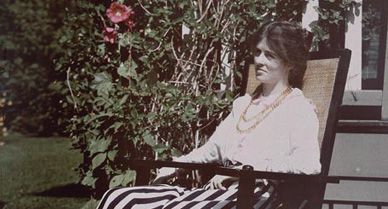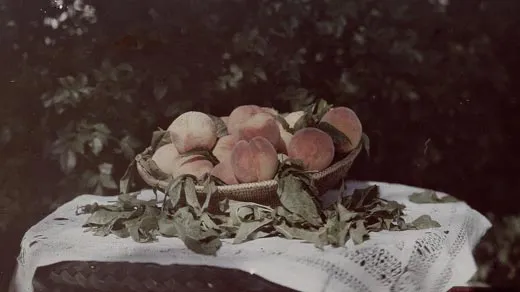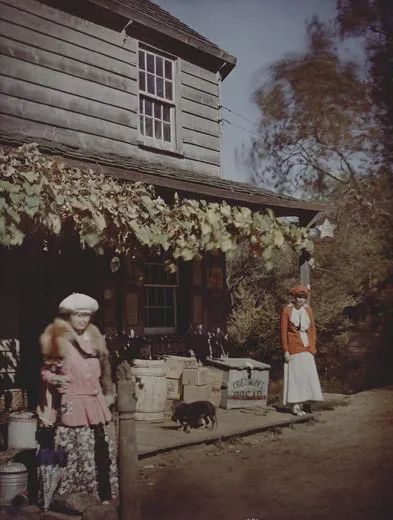In Living Color
An obscure photographic process unveiled 100 years ago opens a fresh window on the past
The most improbable object imaginable—the lowly, lumpy potato—played a leading role in the Great Leap Forward of color photography. The story begins in 1903, when two imaginative French inventors, Auguste and Louis Lumière, seized the pomme de terre and made it the basis for a dazzling new imaging process they called the autochrome, an innovation that would transform a monochromatic world into one suddenly gleaming with color.
"The palette and canvas are a dull and lifeless medium by comparison," raved Edward Steichen, one of many photographers eager to embrace the color process, which armed ordinary people with a practical way to make color pictures.
The Lumières' invention, patented in 1903 and unveiled at the Paris Photo Club in 1907, seems complicated when compared with today's point, shoot and enjoy picture-taking. But in its time the autochrome was hailed as a dramatic improvement over existing methods for color photography, which required setting up three cameras, recording separate but identical subjects through three different color filters and superimposing one image over the other to form a single picture.
The Lumières changed all that. Tinkering in their family's Lyon factory, which produced millions of black-and-white camera-ready plates for the masses, the Lumière brothers gathered up their potatoes and ground them into thousands of microscopic particles; they separated this powder into three batches, dying one batch red-orange, one violet and one green; the colored particles were thoroughly mixed and sifted onto a freshly varnished, clear glass plate while the lacquer remained tacky; excess potato bits were swept from the plate, which was pressed through steel rollers to flatten the colored grains, transforming each into a minuscule color filter measuring from .0006 to .0025 millimeters across. Gaps between the colored particles were filled in with carbon black, the plate was varnished again and a thin, light-sensitive emulsion of silver bromide was brushed over that. Now the plate was ready for the camera. When the shutter was opened, light filtered through the translucent potato grains, and a multicolored image was imprinted on the emulsion. After the negative plate was developed in the lab, it was washed and dried, covered with another piece of glass to protect the emulsion and bound with gummed tape. Et voilà! A color photograph unlike any seen before.
Filtered through the camera lens, a layer of varnish and the thin mosaic screen of potato granules, the autochrome images were cast in muted tones, at once dreamlike and vibrant, more reminiscent of a pointillist painting than an absolute rendering of life from nature. The autochrome's long exposure times—at least 60 seconds—required subjects to hold perfectly still, which contributed to the images' calm, even stately, look. (This aesthetic is celebrated in "100 Years of Autochrome," on view at the Amon Carter Museum in Fort Worth through July 27, 2008.)
It was almost certainly the autochrome's painterly qualities that attracted photographic pioneers like Edward Steichen and Alfred Stieglitz to the ranks of autochrome enthusiasts, many of whom had been trained as painters before they switched to cameras. Stieglitz, who worked tirelessly to raise the photographic craft to the level of fine art, sought out the Lumière brothers so that he could master their new photographic methods; he, in turn, attracted disciples like Alvin Coburn, who shuttled between Britain and the United States shooting portraits of such famous characters as Henry James, George Bernard Shaw and Mark Twain.
"I have the color fever badly," the brash young Coburn told Stieglitz in 1907, just as the Lumières were launching the autochrome era. Others caught the fever too. The Lumière factory in Lyon cranked up production, but the firm initially had trouble meeting demand from the legions of newly recruited color devotees.
On one of his frequent visits to the United States, Coburn found a fellow enthusiast for color photography in Redding, Connecticut, named Mark Twain. The famous author agreed to sit for Coburn in 1908. Known for dressing outlandishly, Twain obviously enjoyed posing for the photographer. He changed costumes throughout the day, switching from his signature white suit into gaudy Oxford academic robes (red, violet and white), then into a red dressing gown. He stood on a pedestal in the garden pretending to be a living sculpture. "Why should not I be the statue?" Twain asked.
When Twain tired of photography, he, Coburn and other visitors passed the day playing cards and shooting billiards. "It was understood," Coburn remembered, "that our good host, clad in white, was to be allowed to win in all these contests, by just the narrowest of margins! Mr. Clemens enjoyed being photographed."
And so, obviously, did the thousands of others who made autochrome king of the photographic world for the next 30 years, until it was overtaken by Kodachrome and Agfacolor film and the compact, easy-to-use 35-millimeter camera, which allowed photographers to blend in, move fast and render a rapidly changing world in bright colors. Nothing would look quite so mellow after that.
Robert M. Poole, a regular contributor, was executive editor of National Geographic magazine.



